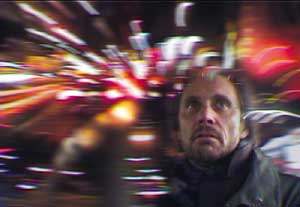SEND IN THE CLOWNS • ONLY CONNECT
Sunflowers by Elmer Wayne Henley
SEND IN THE CLOWNS
The debate over minimum-wage prison laborers producing designer clothes and other luxury items generates occasional headlines, but few topics evince as volatile a response as that of death-row inmates-turned-artists who sell their paintings – often depicting what critics deem mockingly unrepentant subject matter – to the public at large. Julian P. Hobbs’s new feature documentary Collectors offers little insight into the minds of convicts making a killing in the art world but instead focuses on the individuals who actively collect and fetishize their work.
Joe Coleman, an artist renowned for his own gore-filled paintings, compares the collector’s motivation with that of the serial killer, citing Ed Gein’s practice of digging up women’s corpses and clothing himself in their flayed skin as a way of being "closer" to his dead mother. "The need to possess totems of death," explains Coleman, an avid collector, derives from a belief in their "shamanistic power to ward off evil."
Rick Staton, a dealer of death-row art, is somewhat more pedestrian. While he admits to being fascinated "with the ghoulish horror of the crimes and by the brush with deviant celebrity," after 20 years working as a mortician he began corresponding with death-row inmates more out of "boredom."
Tobias Allen, creator of a controversial serial-killer board game, is even more succinct: "What separates them from us?" he asks.
Collectors principally focuses on Staton and Allen as they discuss their obsessive hobby (Richard Ramirez, the infamous Night Stalker, Staton explains helpfully, "is second only to John Wayne Gacy in terms of the popularity of his art"; Charles Manson, on the other hand, "produces crappy art but has a famous name") and follows them as they go on pilgrimages to various crime scenes where they gather dirt samples and take photographs. But the film also gives voice to the families of victims and to victims’ rights advocates who are appalled by the industry that has grown up around convicted murderers.
Surprisingly, Elmer Wayne Henley, the only living serial killer interviewed in the film, is reticent to produce macabre images but does so on occasion to appease Rick Staton, who acts as his dealer. Normally, he says, he prefers to paint landscapes.
Collectors premiered at the SXSW Film Festival. (Contact: www.abjectfilms.com) – Steve Gallagher
ONLY CONNECT
As Adam Gopnik pointed out in a recent "Talk of the Town" column in The New Yorker, new technologies have done little to advance communication, and they may have taken us a step backward. "E-mail has succeeded brilliantly," he wrote, "for the same reason the videophone failed miserably: what we actually want from our exchanges is the minimum human contact commensurate with the need to connect with other people."
 Scott Saunders’s This Close to Nothing, a short co-written with and featuring Michael Harris (pictured right), challenges this premise but ultimately concedes defeat. In the film, which intercuts present time with flash- forwards — and is fittingly shot with a digital camcorder and edited using off-the-shelf software — boy meets girl online, they hook up, get drunk, clumsily fuck and then, panic-stricken, girl locks boy out of her apartment ... without his coat or money, on a cold winter night.
Scott Saunders’s This Close to Nothing, a short co-written with and featuring Michael Harris (pictured right), challenges this premise but ultimately concedes defeat. In the film, which intercuts present time with flash- forwards — and is fittingly shot with a digital camcorder and edited using off-the-shelf software — boy meets girl online, they hook up, get drunk, clumsily fuck and then, panic-stricken, girl locks boy out of her apartment ... without his coat or money, on a cold winter night.
Although he described the desktop setup he used on This Close... as "a nightmare," Saunders — who completed two prior features on analog video — is nonetheless optimistic about the digital revolution. "It’s people who really scare me!" he joked. This Close... premiered at the Los Angeles Independent Film Festival. (Contact: Scott Saunders, scopix@aol.com) — S.G.
VOD CALENDAR


 See the VOD Calendar →
See the VOD Calendar →



